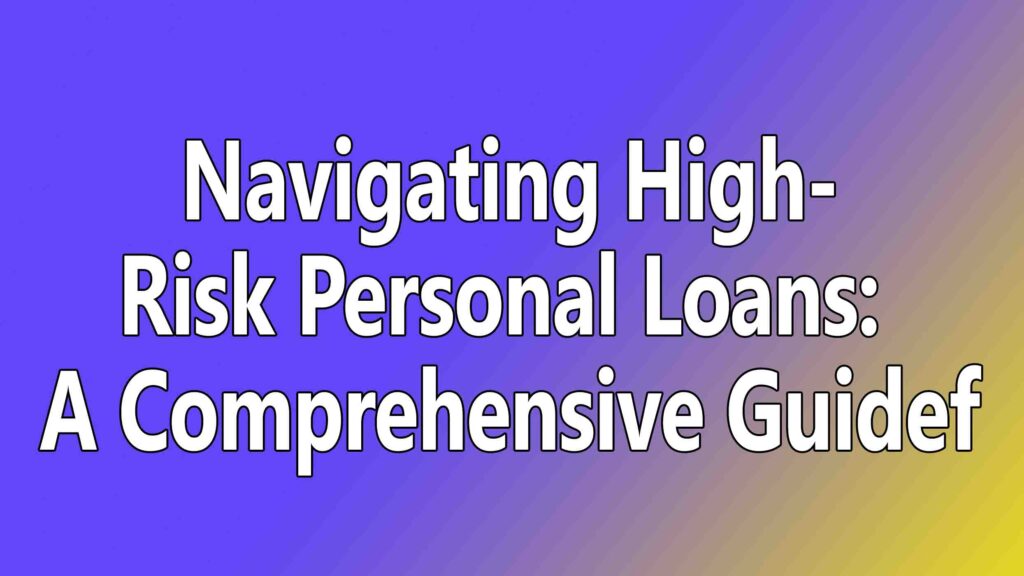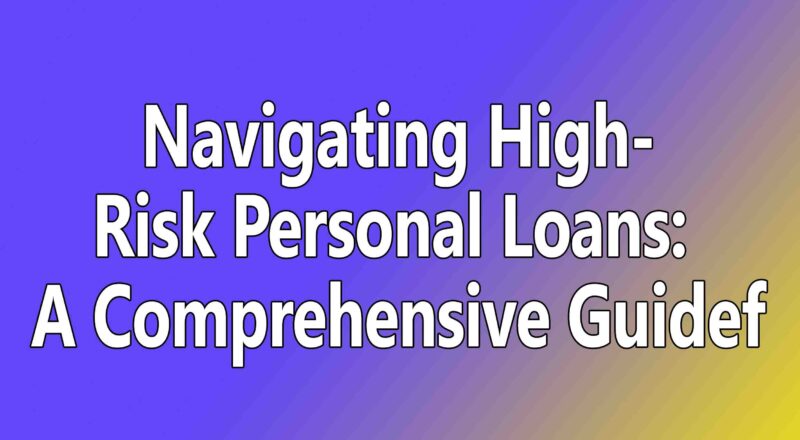Navigating High-Risk Personal Loans: A Comprehensive Guide

Navigating High-Risk Personal Loans: A Comprehensive Guide: Personal finance isn’t always plain sailing. Economic downturns, unexpectedly high expenses, and misspent youth can lead even the most capable individuals to a rocky financial shore.
For those with a less-than-perfect credit score, the waters become even choppier. This comprehensive guide is designed to serve as a beacon of knowledge and security as you explore the world of high-risk personal loans guaranteed approval direct lenders.
We’ll help you chart your course from the initial application to building a foundation for better financial opportunities in the future.
Understanding High-Risk Personal Loans
High-risk personal loans are a lifeline for individuals who, due to various reasons, are considered high-risk borrowers by traditional lending institutions.
These loans cater to those with poor credit scores, a history of missed payments, or limited credit histories. They often come with higher interest rates, stricter terms, and additional fees due to the increased risk for the lender.
Who Qualifies as a High-Risk Borrower?
The criteria for being labeled high-risk can vary between lenders, but common indicators include:
- A credit score below a certain threshold
- High existing debt levels
- Consistent late payments on previous credit accounts
- Lack of significant credit history
- Bankruptcy or foreclosure history
Pros and Cons for the Borrower
The main advantage of high-risk personal loans is, as the name suggests, their guarantee of approval, which can be a critical lifeline for those in urgent need of funds.
On the flip side, the cost of borrowing can be significantly higher, and the terms may not be as favorable compared to loans tailored for low-risk borrowers. It’s essential to weigh these considerations against the urgency of your financial need and potential alternatives.
Factors to Consider Before Applying
Before you sign the dotted line of a high-risk personal loan agreement, there are several key factors to evaluate to ensure you’re making the right decision for your financial health.
Assessing Your Financial Situation
Take a deep dive into your finances. Calculate your current debt-to-income ratio and determine if there are areas where you can cut back on spending to ease your financial burden. Ask yourself if the loan is a necessity or a want.
Understanding the Risks
High-risk loans often mean high risk for the borrower as well. What are the potential consequences of not being able to meet the stringent repayment terms? Understand the worst-case scenarios and have a plan in place.
Alternatives to High-Risk Personal Loans
Consider other options such as credit unions, peer-to-peer lending, or borrowing from family and friends. Some may offer better terms or more flexible options than high-risk personal loans.
Finding Reputable Direct Lenders
Scams and predatory lending are unfortunately not uncommon within the high-risk loan market. Protect yourself from these hazards by diligently researching potential lenders.
Research Tips and Red Flags
Research isn’t merely searching for online reviews; it’s confirming a lender’s legitimacy through state registration and whether they adhere to industry best practices. Red flags can include overly pushy sales tactics, undisclosed fees, or promises that seem too good to be true.
Fine Print: A Borrower’s Bible
The loan agreement’s fine print can contain vital information about your responsibilities and the lender’s rights. Read and understand every clause before agreeing to anything. If something is unclear, ask for clarification.
Guaranteed Approval vs. Responsible Borrowing
The term “guaranteed approval” can be music to the ears of a high-risk borrower, but it should also raise a note of caution. While it’s true that many direct lenders are more lenient in their approval processes, this doesn’t absolve the borrower from the responsibility of assessing whether the loan is affordable and in their long-term best interest.
The Illusion of No Rejection
Remember that guaranteed approval is a marketing tactic and not a substitute for fair and ethical lending practices. No reputable lender can guarantee approval without a credit check or income verification process.
Building a Responsible Borrowing Mindset
Responsible borrowing extends beyond on-time payments – it includes meticulous pre-loan preparation, limiting high-interest borrowing to absolute necessity, and continually seeking to improve your financial knowledge and habits.
Improving Creditworthiness for Future Borrowing
A high-risk personal loan is often a stepping stone for borrowers to improve their financial circumstances and access better loan options in the future. It’s an opportunity to demonstrate creditworthiness and rebuild financial health.
Boosting Your Credit Score
Start with simple steps like paying bills on time, reducing your credit card balances, and refraining from applying for new credit. Over time, these actions will elevate your credit score and position you as a more favorable borrower.
Building a Solid Financial Foundation
High-risk borrowers often lack robust financial foundations. Use the loan to start an emergency fund or invest in education that will lead to better job prospects. The more solid your financial ground, the less need you’ll have for high-risk loans in the future.
In Conclusion
The decision to take out a high-risk personal loan guaranteed approval direct lenders isn’t one to make lightly, but with the right knowledge and approach, it can be a tool to regain control of your financial situation.
Remember, financial health is a long game, and each decision plays a part in the overall outcome. Arm yourself with the information in this guide, make informed choices, and look to the future with an empowered financial vision.
